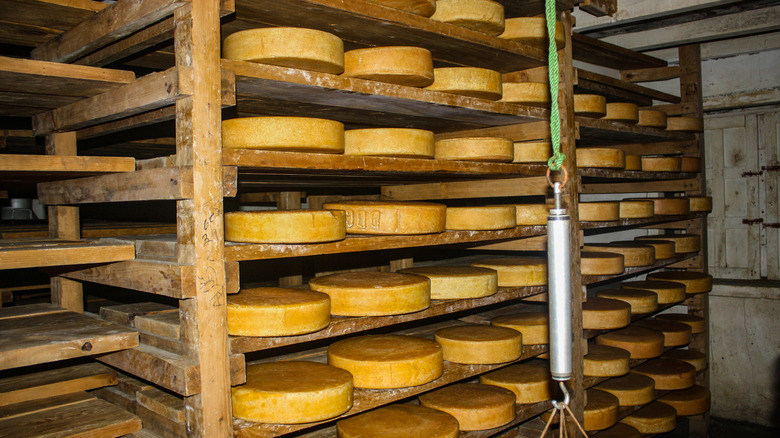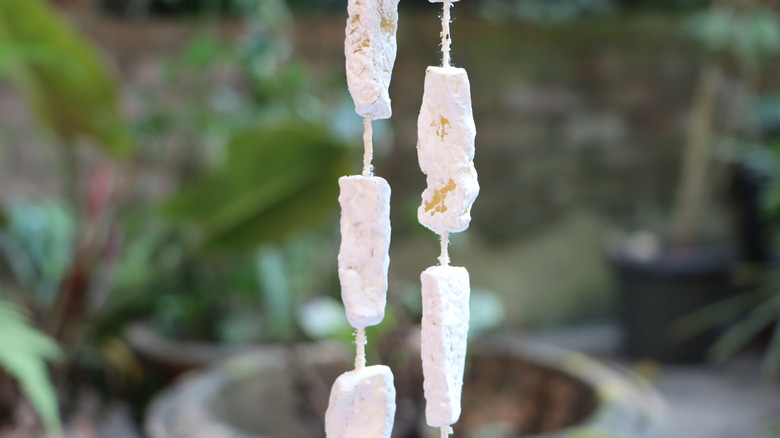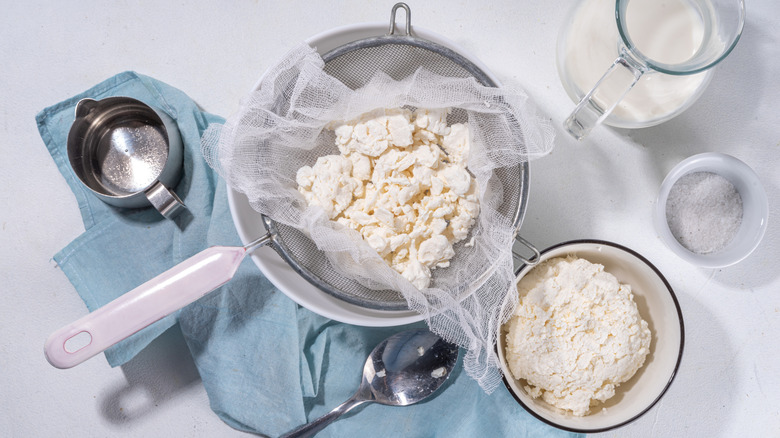The Cheese So Hard It Could Break Your Teeth
We may receive a commission on purchases made from links.
Chhurpi is a traditional cheese, an ancient Himalayan travel snack created by hardy people carving out their existence in harsh conditions — and breeding a male yak with a female cow. The resulting animal is a chauri, a resilient bovine that weathers the harsh conditions of the Himalayas very well. Chauri, like yak, produce nutrient-dense milk with a flavor stronger than cow's milk, and chauri milk is what cheese makers in the Eastern Himalayas have used for centuries to make chhurpi, also known as Durkha or yak cheese. Chhurpi is a protein-dense and heart-healthy dairy product that you'll see in a few varieties. There's a soft version used in recipes and on snack boards, smoked chhurpi, yak cheese curds, and long-cured hard chhurpi; the latter is a cheese known as the hardest in the world, hard enough to crack your teeth.
In Nepal, Tibet, Bhutan and Eastern India, hard chhurpi is a popular snack and cooking ingredient for locals and tourists alike. It's unwise to try and bite through small chunks of chhurpi; instead, you treat chhurpi like savory taffy that softens as you chew. Making traditional hard chhurpi is a long and laborious process that requires separating curds and months of aging. While this rare cheese is intertwined with the history of the Himalayas, you can find it outside of the region and you can even make it yourself at home in a process that doesn't have to take quite as long.
How to buy and use chhurpi outside of the Himalayas
You could hop on a plane to Nepal and wander through Kathmandu's markets to find every form of chhurpi you could imagine. As you explore, you could chew on a little square of hard chhurpi, or you could order a plate of cheesy momos, little traditional Himalayan dumplings filled with soft chhurpi and spices like turmeric and cumin. You could travel all the way to Nepal for a good chunk of chhurpi, or you could turn to online sources for packaged products like Snow Hill chhurpi nuggets. Specialty cheese shops may also carry different varieties of chhurpi, especially those catering to Indian and Nepalese cuisine.
There are dozens of recipes to try at home that incorporate chhurpi, since the cheese is used in so many traditional dishes from the Himalayas. It's the key ingredient for Ema datshi, a traditional creamy white potato soup, and is used in many other soups and stews from the region. Chhurpi is also a main ingredient in the famous, somewhat spicy side dish known as churpi ko achar. You can make ice cream out of fresh chhurpi and top it with traditional chocolate and sprinkles or douse your scoops in a shot of booze for an extra special dessert. Hard chhurpi is also grated over dishes and turned into a powder to flavor all kinds of recipes.
Try your hand at homemade chhurpi
Chhurpi is traditionally made with yak milk, which you can find in powdered form online if a fresh source is unavailable. If you don't want to go on a mission for yak milk, though, you can make chhurpi at home using buttermilk, or a mixture of cow's milk and vinegar or lemon juice, and get a very similar result. The process requires the yak milk, cow's milk mixture, or buttermilk to be boiled until curds begin to separate from the liquid, which are then fished out and wrapped in cheesecloth. The curds then compress under pressure for a few hours to dry them out; they're then left to cure for two to three days and sliced into smaller pieces for easy snacking.
Hard chhurpi requires the extra step of leaving the cheese out in the sun or putting it in the oven on low heat. This process further preserves it by drying it out even more. You can hold onto your hard chhurpi for pretty much as long as you'd like — some people store it in yak skin and set it aside to cure for four or five years before they break into their homemade chhurpi, though by some accounts the stuff can last up to two decades. Eat homemade chhurpi with a side of the fluffiest homemade naan you've ever tasted, and hand-grind your favorite spices into the rest of your meal, and you'll have a traditional Himalayan meal in your own home.


